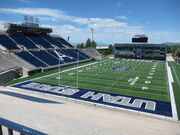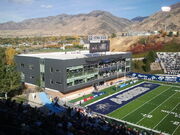| Maverik Stadium | |
|---|---|
| Location | 800 East 1400 North, Logan, Utah 84322 |
| Broke ground | 1968 |
| Opened | September 14, 1968 |
| Renovated | 1980, 1999, 2005, 2006 |
| Owner | Utah State University |
| Operator | Utah State University |
| Surface | AstroTurf GameDay Grass 3D60 Extreme - (2012-present) SprinTurf - (2004-2011) Natural grass - (1968-2003) |
| Construction cost | $3 million ($20.3 million in 2014 dollars) |
| Architect | Cannon & Mullen |
| Former names | Romney Stadium |
| Tenants | Utah State Aggies (NCAA) (1968–present) |
| Capacity | 25,513 (2006-present)[1] 30,257 (1980-2005) 20,000 (1968-1979) |
Merlin Olsen Field at Maverik Stadium is an outdoor football stadium in Logan, Utah, on the campus of Utah State University (USU). It is the home field of the Utah State Aggies of the Mountain West Conference. It opened in 1968 and currently has a seating capacity of 25,513. Its AstroTurf GameDay Grass playing field runs in the traditional north-south configuration, and sits at an elevation of 4710 feet (1435 m) above sea level.[2]
Prior to 2015, the stadium was named Romney Stadium in honor of Dick Romney, Utah State’s all-time most successful football coach and former athletics director. Romney Stadium was officially dedicated on September 27, 1969. The first game in the stadium came a season earlier in 1968, when USU defeated New Mexico State 28–12 on September 14. On April 11, 2015, the stadium was renamed Maverik Stadium as part of a naming rights deal with the Maverik convenience store chain.
History[]
Prior to the construction of the first Romney Stadium, intercollegiate and intramural competition took place on a makeshift field east of Old Main. This area, which would eventually become the Quad, served the needs of the college’s football and track teams until 1913. According to historian A.J. Simmonds, it “was the responsibility of players to pick the rocks off the playing field before matches.” Student Phebe Nebeker recalled the field’s appearance after accompanying her future husband, Elmer G. Peterson, to a contest in 1903. “It wasn’t anything like what we think of today as a football stadium. It was merely a somewhat flat area - with a little grass here and there - that was very muddy when it rained and very hard when it didn’t. One small set of bleachers had been erected near the southeast corner of Old Main, but most of the patrons had to stand or sit on patches of grass along the playing field.”[3]
In 1913, College contests began taking place at Adams Field, located west of Old Main Hill on the east side of the present Adams Park. Although Adams Field represented an improvement, it did not provide the type of facility which could launch the Aggies into competitive intercollegiate play. The sparse facilities became more obvious after the College employed Coach Lowell “Dick” Romney in 1918, and Aggie football began experiencing considerable success.[4]
First Romney Stadium[]
The original Romney Stadium was built in 1927 on the grounds where the Health, Physical Education and Recreation (HPER) building now stands. That facility was dedicated on Oct. 8, 1927 in recognition of Coach E.L. "Dick" Romney's lasting contributions to Utah State football. That structure served as Utah State’s home for 41 seasons (1927–67). Utah State played its final game in the old complex on Nov. 11, 1967, as the Aggies defeated Montana, 20-14.[5]
Current Romney Stadium[]
The stadium retained the Romney name as it was relocated farther north on Utah State's campus to its present location. The first game in the current Romney Stadium was played on Sept. 14, 1968 when the Aggies defeated New Mexico State, 28-12, and the facility was officially dedicated on Sept. 27, 1969. The stadium was financed by a student body which believed in athletics to the extent of underwriting a special bonding assessment for both Romney Stadium and the Dee Glen Smith Spectrum, which serves as home for Utah State’s basketball, gymnastics and volleyball teams.[6]
There has been one major stadium addition since 1969. Thanks to a massive volunteer effort in 1980, 10,000 seats were added to the southern bowl which brought the capacity of the stadium to 25,513. Prior to the 1997 season, approximately 4,000 chair back seats replaced wooden bleachers on the west side of the stadium. Ahead of the 1999 season, new scoreboards were added at each end of the stadium and additional bleacher seats were installed as well. New aluminum bleachers replaced wooden bleachers on the lower sections of the east side of the stadium in 2001. In 2003 that project expanded to the upper sections. In the summer of 2004, the bent bluegrass field was replaced with a state of the art synthetic turf by SprinTurf. Prior to the 2005 season a new south end entrance, improved concession stands and restroom facilities as well as a widened concourse on the east side of the stadium were completed.[7]

The field and stadium as they presently appear. The new athletic logo and word marks are shown on the newly installed turf with the Laub Athletics-Academics Complex in the far end zone.
On December 5, 2009, USU announced that the field at Romney Stadium would be named Merlin Olsen Field in honor of Pro and College Football Hall of Fame member and former Aggie Merlin Olsen.[8] Following Olsen's death in March 2010, Utah State dedicated a statue in his honor in a ceremony held on October 23, 2010. The bronze statue, created by Utah sculptor Blair Buswell, depicts Olsen during his college playing days at USU - in full uniform and pads, with his helmet under his arm - and stands outside the south entrance of Romney Stadium.[9]
Following the unveiling of new Utah State athletics logos and prior to the home opener of the 2012 football season, the playing surface on Merlin Olsen Field was replaced. The SprinTurf, which was installed in 2004, was replaced by AstroTurf GameDay Grass 3D60 Extreme and the new athletic logo replaced the old at center field. The new end zones are navy blue with the “Utah State” word mark in the south end zone and the “Aggies” word mark in the north end zone, bookended by the new bull logo.[10]
Laub Athletics-Academics Complex[]

Laub Athletics-Academics Complex
Immediately after the 2006 season, the old north end zone complex was torn down and replaced with a three-story, 55,000 square foot facility called The Jim & Carol Laub Athletics-Academics Complex. It was completed in 2008.[11] The facility houses the Dale Mildenberger Sports Medicine Complex, the Dr. John Worley Sports Medicine Research Center, the Steve Mothersell Hall of Fame, equipment room, locker rooms, coaches offices, meeting rooms, luxury suites and a student-athlete academic center.[12]
New Strength and Conditioning Center[]
On May 26, 2012, a groundbreaking ceremony was held for the construction of a new strength and conditioning center. The new facility will be located on the northwest corner of Romney Stadium directly west of the Laub Athletics-Academics Complex. The $6.4 million, 21,000 square-foot strength and conditioning center will feature areas for weight training, cardiovascular workouts and speed and agility training, as well as offices for staff. The facility, which was made possible due to the largest single gift in the history of Aggie Athletics from an anonymous donor, is expected to be completed in April 2013.[13]
Team history at Romney Stadium[]
Dick Romney guided the Aggies to four conference championships, compiling a 128-91-16 record (.579) in 29 seasons (1919–48). Over the past 33 seasons, Utah State has compiled a 94-69 mark (.577) winning percentage) in the current Romney Stadium. Only nine times in the 33-year history of the stadium has Utah State experienced a losing record at home.
Utah State’s largest crowd to witness a game in Romney Stadium was 33,119 (including standing room) in a 45-17 loss to BYU on October 4, 1996.[14]
References[]
- ↑ utahstateaggies.cstv.com
- ↑ Topographic map from USGS via Microsoft Research Maps
- ↑ Parson, Robert. An Encyclopedic History of Utah State University. Utah State University. Retrieved on 28 October 2012.
- ↑ Parson, Robert. An Encyclopedic History of Utah State University. Utah State University. Retrieved on 28 October 2012.
- ↑ 2009 Football Media Guide. Utah State University. Retrieved on 21 October 2012.
- ↑ 2009 Football Media Guide. Utah State University. Retrieved on 21 October 2012.
- ↑ 2009 Football Media Guide. Utah State University. Retrieved on 21 October 2012.
- ↑ Harrison, Shawn. Field named after Olsen: Utah State honors Aggie legend in halftime ceremony. The Herald Journal. Retrieved on 21 October 2012.
- ↑ Merlin Olsen statue to be unveiled today. The Herald Journal. Retrieved on 21 October 2012.
- ↑ Denniston, Wade. Romney Stadium gets field makeover. The Herald Journal. Retrieved on 21 October 2012.
- ↑ Jim & Carol Laub Athletics-Academics Complex. Utah State University. Retrieved on 21 October 2012.
- ↑ 2009 Football Media Guide. Utah State University. Retrieved on 21 October 2012.
- ↑ Utah State Athletics Holds Ground Breaking Ceremony For New Strength and Conditioning Center. Utah State University. Retrieved on 21 October 2012.
- ↑ NCAAFootball.com page on Romney Stadium
External links[]
- Utah State Aggies.com - official athletics site - Romney Stadium
- Aerial photo (& topographic map) of USU campus from USGS via Microsoft Research Maps
| This page uses Creative Commons Licensed content from Wikipedia (view authors). |

